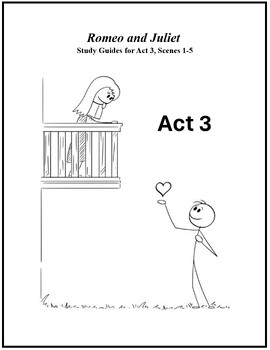

This resource can be used by students on Google Drive or Google Classroom. To access this resource, you’ll need to allow TPT to add it to your Google Drive. See our FAQ and Privacy Policy for more information.

The Act 3 Romeo and Juliet study guide can be used as a scaffold, reading quiz, group work, or individual study. An extensive answer key is provided. Students will develop an understanding of the plot and practice citing strong and thorough textual evidence to support analysis. While the cognitive complexity of the questions falls within levels three and four of Dr. Norman L. Webb's renowned Depth of Knowledge framework, sentence stems are included to provide differentiation for those students who struggle with articulating sophisticated analysis (Plymouth Community School Corporation, 2024). If you are looking for questions on levels one and two of Webb's Depth of Knowledge framework, this is not the resource for you.
There are also clear learning objectives that align with the questions, guiding learners through a comprehensive analysis of the play.
Act 3, Scene 1
Act 3, Scene 2
Act 3, Scene 3-4
Act 3, Scene 5
RL.1 Cite strong and thorough textual evidence to support analysis of what the text says explicitly as well as inferences drawn from the text.
RL. 2 Determine a theme or central idea of a text and analyze in detail its development over the course of the text, including how it emerges and is shaped and refined by specific details; provide an objective summary of the text.
RL. 3 Analyze how complex characters (e.g., those with multiple or conflicting motivations) develop over the course of a text, interact with other characters, and advance the plot or develop the theme.
RL. 4 Determine the meaning of words and phrases as they are used in the text, including figurative and connotative meanings; analyze the cumulative impact of specific word choices on meaning and tone.
RL. 5 Analyze how an author’s choices concerning how to structure a text, order events within it, and manipulate time create such effects as mystery, tension, or surprise.
W. 9 Draw evidence from literary or informational texts to support analysis, reflection, and research.
Character (CHR) Identify and describe what specific textual details reveal about a character, that character’s perspective, and that character’s motives.
Setting (SET) Describe the relationship between a character and a setting (The environment a character inhabits provides information about that character).
Structure (STR) The dramatic situation of a narrative includes the setting and action of the plot and how that narrative develops to place characters in conflict(s), and often involves the rising or falling fortunes of a main character or set of characters.
Figurative Language (FIG) Distinguish between the literal and figurative meanings of words and phrases. Explain the function of specific words and phrases in a text.
Reference
Plymouth Community School Corporation. (2024). Webb's depth of knowledge resources.